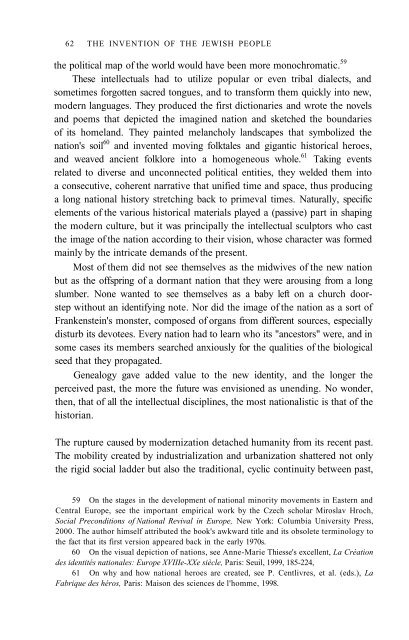Shlomo Sand, The Invention of the Jewish People - Rafapal
Shlomo Sand, The Invention of the Jewish People - Rafapal
Shlomo Sand, The Invention of the Jewish People - Rafapal
You also want an ePaper? Increase the reach of your titles
YUMPU automatically turns print PDFs into web optimized ePapers that Google loves.
62 THE INVENTION OF THE JEWISH PEOPLE<br />
<strong>the</strong> political map <strong>of</strong> <strong>the</strong> world would have been more monochromatic. 59<br />
<strong>The</strong>se intellectuals had to utilize popular or even tribal dialects, and<br />
sometimes forgotten sacred tongues, and to transform <strong>the</strong>m quickly into new,<br />
modern languages. <strong>The</strong>y produced <strong>the</strong> first dictionaries and wrote <strong>the</strong> novels<br />
and poems that depicted <strong>the</strong> imagined nation and sketched <strong>the</strong> boundaries<br />
<strong>of</strong> its homeland. <strong>The</strong>y painted melancholy landscapes that symbolized <strong>the</strong><br />
nation's soil 60 and invented moving folktales and gigantic historical heroes,<br />
and weaved ancient folklore into a homogeneous whole. 61 Taking events<br />
related to diverse and unconnected political entities, <strong>the</strong>y welded <strong>the</strong>m into<br />
a consecutive, coherent narrative that unified time and space, thus producing<br />
a long national history stretching back to primeval times. Naturally, specific<br />
elements <strong>of</strong> <strong>the</strong> various historical materials played a (passive) part in shaping<br />
<strong>the</strong> modern culture, but it was principally <strong>the</strong> intellectual sculptors who cast<br />
<strong>the</strong> image <strong>of</strong> <strong>the</strong> nation according to <strong>the</strong>ir vision, whose character was formed<br />
mainly by <strong>the</strong> intricate demands <strong>of</strong> <strong>the</strong> present.<br />
Most <strong>of</strong> <strong>the</strong>m did not see <strong>the</strong>mselves as <strong>the</strong> midwives <strong>of</strong> <strong>the</strong> new nation<br />
but as <strong>the</strong> <strong>of</strong>fspring <strong>of</strong> a dormant nation that <strong>the</strong>y were arousing from a long<br />
slumber. None wanted to see <strong>the</strong>mselves as a baby left on a church doorstep<br />
without an identifying note. Nor did <strong>the</strong> image <strong>of</strong> <strong>the</strong> nation as a sort <strong>of</strong><br />
Frankenstein's monster, composed <strong>of</strong> organs from different sources, especially<br />
disturb its devotees. Every nation had to learn who its "ancestors" were, and in<br />
some cases its members searched anxiously for <strong>the</strong> qualities <strong>of</strong> <strong>the</strong> biological<br />
seed that <strong>the</strong>y propagated.<br />
Genealogy gave added value to <strong>the</strong> new identity, and <strong>the</strong> longer <strong>the</strong><br />
perceived past, <strong>the</strong> more <strong>the</strong> future was envisioned as unending. No wonder,<br />
<strong>the</strong>n, that <strong>of</strong> all <strong>the</strong> intellectual disciplines, <strong>the</strong> most nationalistic is that <strong>of</strong> <strong>the</strong><br />
historian.<br />
<strong>The</strong> rupture caused by modernization detached humanity from its recent past.<br />
<strong>The</strong> mobility created by industrialization and urbanization shattered not only<br />
<strong>the</strong> rigid social ladder but also <strong>the</strong> traditional, cyclic continuity between past,<br />
59 On <strong>the</strong> stages in <strong>the</strong> development <strong>of</strong> national minority movements in Eastern and<br />
Central Europe, see <strong>the</strong> important empirical work by <strong>the</strong> Czech scholar Miroslav Hroch,<br />
Social Preconditions <strong>of</strong> National Revival in Europe, New York: Columbia University Press,<br />
2000. <strong>The</strong> author himself attributed <strong>the</strong> book's awkward title and its obsolete terminology to<br />
<strong>the</strong> fact that its first version appeared back in <strong>the</strong> early 1970s.<br />
60 On <strong>the</strong> visual depiction <strong>of</strong> nations, see Anne-Marie Thiesse's excellent, La Création<br />
des identités nationales: Europe XVIIIe-XXe siècle, Paris: Seuil, 1999, 185-224,<br />
61 On why and how national heroes are created, see P. Centlivres, et al. (eds.), La<br />
Fabrique des héros, Paris: Maison des sciences de l'homme, 1998.




